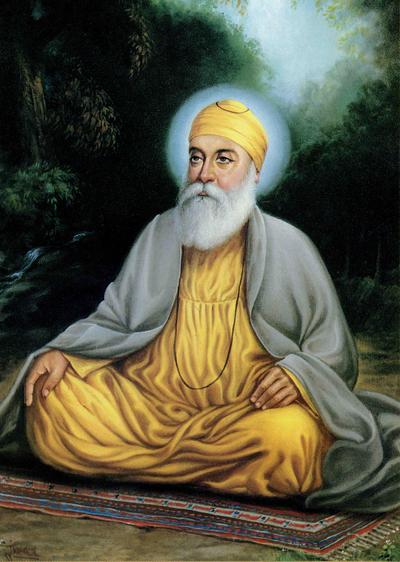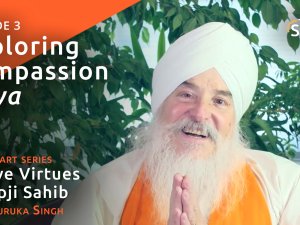 Over 500 years ago, Guru Nanak taught that Truth is a universal constant, and nobody has an exclusive right to it. Like the story of the six blind men describing an elephant, most of us have our own version of truth. Fortunately, there have been enlightened teachers like Guru Nanak who periodically come to remind us of the ultimate truth underlying the unity of humankind. They serve to awaken each of us to our own highest consciousness. Within the context of their historical time and space, these great souls have all taught the same universal truths of infinite consciousness. Many of these teachings became the foundation for the world’s religions.
Over 500 years ago, Guru Nanak taught that Truth is a universal constant, and nobody has an exclusive right to it. Like the story of the six blind men describing an elephant, most of us have our own version of truth. Fortunately, there have been enlightened teachers like Guru Nanak who periodically come to remind us of the ultimate truth underlying the unity of humankind. They serve to awaken each of us to our own highest consciousness. Within the context of their historical time and space, these great souls have all taught the same universal truths of infinite consciousness. Many of these teachings became the foundation for the world’s religions.
The Sikh path began in India when a man called Nanak said that people shouldn’t fight about how to worship God. He proclaimed that there is One God, one universal Creative Energy, which pervades the entire creation (ek ong kaar), so we should respect all religions.
Guru Nanak saw God everywhere, in everyone. To him, everyone was equal in the eyes of God. At a time of widespread religious intolerance in India, Guru Nanak said, “There is no Hindu, there is no Muslim.” This was a unique perspective, when Hindus were objects of scorn, suffering unspeakable persecution by the Mughal conquerors.
Those who followed Nanak’s teachings, his students, were called shishyas or as we now say, “Sikhs.” He was called Guru, a general term which means “Teacher.” Actually, for Sikhs, the title of “Guru” is very specific, for only Guru Nanak and his successors are ever accorded that special title.
In the Hindu tradition, many spiritual teachers are called gurus. In the Western world since the 1960s, it was common to call any teacher from India who sets up shop on these shores a “guru.” Now the term “guru” is used to describe your tennis instructor (“tennis guru”), or even your financial advisor (“money guru”). To Sikhs, the term is sacred, and can never be applied to anyone except Guru Nanak and his successors. Yogi Bhajan, a very devout Sikh, was very emphatic that we must never call him “guru.”
“Guru” in the Sikh tradition is an enlightened messenger of the Timeless. The Sikh Gurus served as reminders of the eternal wisdom, which is free from bigotry, rejects superstitions, dogmas and empty rituals, and emphasizes the value of a sacred life.
Guru Nanak was a Teacher whose words transformed andelevated the listener. He taught through the example of his life, and the words that flowed through him came out in exquisite poetry with mantric power. He formed analogies and comparisons to current happenings to educate and inspire people to discard superstition and empty rituals. His words awakened rich and poor, peasants and emperors, Hindus and Muslims. Both women and men came to be his disciples, students of Truth, his shishyas. Thus Sikhs were born.
Over the period from 1469 to 1708, Guru Nanak laid the foundation for Sikh Dharma, and each of his nine successors added and expanded upon his teachings. By setting exceptional examples, the Gurus taught how to live spiritually fulfilling lives with dignity and honor while remaining active in the world.
The Tenth Guru, Guru Gobind Singh, formally enthroned the Siri Guru Granth Sahib, as the everlasting living Guru. It is the earthly physical container for the vibratory power of the Shabd Guru.There is a saying, “Where you bow, there you shall be blessed.” When a person bows to the Siri Guru Granth Sahib, he or she is bowing to the infinite sound current which holds the universe together, that which is beyond all personality, time, and space. It is the Shabd Guru, the Guru of Guru Nanak, poetry spoken by enlightened beings, and contemporaneously recorded for posterity.
The place where one feels humble before the Infinite is called the Isht. – It is the sacred spot where one bows one’s head in reverence. It can be anywhere. It is personal. Some people climb a mountain, some go deep into the forest, some go to church or temple or have an altar, or “sacred space” at home. The act of bowing gives the physical experience of surrendering, of “giving one’s head,” or mental chatter and personal ego to the Infinite Self. When we bow with humility and reverence to the Shabd Guru, it can create a space of deep openness and connection to the Infinite.
~ Excerpted from the upcoming book: "Heros, Saints and Yogis, and People Like You and Me" by Shakti Parwha Kaur and Guruka Singh





